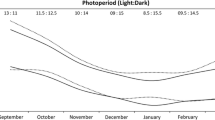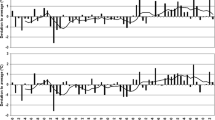Abstract
The host alternating aphid, Rhopalosiphum padi (L.), feeds in summer on several different species of grasses but is monophagous on its winter host, Prunus padus L. The monophagy on P. padus could be a result of the restricted host range of the several different generations colonizing, or feeding, on this host during autumn–winter–spring. This study shows that the winter host plant specificity of R. padi is controlled mainly by the preference of the females remigrating (gynoparae) to the winter host, P. padus, in autumn. The other generations living on the winter host, i.e., sexual females, males, and spring generations, all accept a broader range of winter hosts. One alternative host plant, Prunus spinosa L., could be utilized by all generations associated with the winter host, except for the females remigrating at autumn.
Similar content being viewed by others
REFERENCES
Blackman, R. L., and Eastop, V. F. (1994). Aphids on the World's Trees: An Identification and Information Guide, CAB International/British Museum, Wallingford.
Campbell, C. A. M., Dawson, G.W., Griffiths, D. C., Pettersson, J., Pickett, J. A., Wadhams, L. J., and Woodcock, C. M. (1990). Sex attractant pheromone of damson-hop aphid Phorodon humuli (Homoptera, Aphididae). J. Chem. Ecol. 16: 3455-3465.
Courtney, S. P. (1981). Coevolution of pierid butterflies and their cruciferous foodplants. III. Anthocharis cardamines (L.) survival, development and oviposition on different hostplants. Oecologia 51: 91-96.
Dixon, A. F.G. (1976). Reproductive strategies of the alate morphs of the bird cherry-oat aphid, Rhopalosiphum padi L. J. Anim. Ecol. 45: 817-830.
Dixon, A. F. G., and Glen, D. M. (1971). Morph determination in the bird cherry-oat aphid, Rhopalosiphum padi (L.). Ann. Appl. Biol. 68: 11-21.
Eastop, V. F. (1973). Deductions from the present day host plants of aphids and related insects. In van Emden, H. F. (ed.), Insect/Plant Relationships, Symp. R. Entomol. Soc. London, No. 6. Blackwell, Oxford, pp. 157-178.
Guldemond, J. A. (1990). Choice of host plant as a factor in reproductive isolation of the genus Cryptomyzus (Homoptera, Aphididae). Ecol. Entomol. 15: 43-51.
Guldemond, J. A., Dixon, A. F. G., Pickett, J. A., Wadhams, L. J., and Woodcock, C. M. (1993). Specificity of sex pheromones, the role of host plant odour in the olfactory attraction of males, and mate recognition in the aphid Cryptomyzus. Physiol. Entomol. 18: 137-143.
Hardie, J. (1980). Reproductive, morphological and behavioural affinities between the alate gynoparae and virginoparae of the aphid, Aphis fabae. Physiol. Entomol. 6: 385-396.
Hardie, J., Storer, J. R., Nottingham, S. F., Peace, L., Harrington, R., Merritt, L., Wadhams, L. J., and Wood, D. K. (1994). The attraction of sex pheromone and plant volatiles for field attraction of male bird-cherry aphid, Rhopalosiphum padi. Proc. Brighton Crop Protect. Conf. Pest Dis. 3: 1223-1230.
Heie, O. (1986). The Aphidoidea (Hemiptera) of Fennoscandia and Denmark. III. Fauna Entomologica Scandinavica, Vol 17, E. J. Brill/Scandinavian Science Press, Leiden, Copenhagen.
Hille Ris Lambers, D. (1950). Host plants and aphid classification. Proc. 8th Int. Congr. Entomol., Stockholm, Sweden, 1948, pp. 141-144.
Hille Ris Lambers D. (1979). Aphids as botanists? Symb. Bot. Upssala 22: 114-119.
Humpf, H.-U., and Schreier, P. (1992). 3-Hydroxy-5,6-epoxy-β-ionol β-D-glucopyranoside and 3-hydroxy-7,8-dihydro-β-ionol β-D-glucopyranoside: New C13 norisoprenoid glucoconjugates from sloe tree (Prunus spinosa L.) leaves. J. Agr. Food Chem. 40: 1898-1901.
Janz, N., Nylin, S., and Wedell, N. (1994). Host plant utilization in the comma butterfly: Sources of variation and evolutionary implications. Oecologia 99: 132-140.
Leather, S. R. (1982). Do gynoparae and males need to feed? An attempt to allocate resources in the bird cherry-oat aphid Rhopalosiphum padi. Entomol. Exp. Appl. 31: 386-390.
Leather, S. R. (1986). Host monitoring by aphid migrants: Do gynoparae maximise offspring fitness? Oecologia 68: 367-369.
Mitter, C., and Farrel, B. (1991). Macroevolutionary aspects of insect/plant relationships. In Bernays, E. (ed.), Insect-Plant Interactions, Vol. 3, CRC Press, Boca Raton, FL, pp. 35-78.
Müller, F. P. (1958). Wirtswahlversuche mit Gynoparen von Myzus persicae (Sulz.) und von Aphis fabae Scop. Z. Pflanzenkr. Pflanzensch. 65: 405-411.
Nottingham, S. F., Hardie, J., Dawson, G. W., Hick, A. J., Pickett, J. A., Wadhams, L. J., and Woodcock, C. M. (1991). Behavioral and electrophysiological responses of aphids to host and nonhost plant volatiles. J. Chem. Ecol. 17: 1231-1242.
Pettersson, J. (1970a). Studies on Rhopalosiphum padi (L.). I. Laboratory studies on olfactometric responses to the Prunus padus L. Lantbrk. Annal. 36: 381-399.
Pettersson, J. (1970b). An aphid sex attractant. Entomol. Scand. 1: 63-73.
Pettersson, J. (1993). Odour stimuli affecting autumn migration of Rhopalosiphum padi (L.) (Hemiptera, Homoptera). Ann. Appl. Biol. 122: 417-425.
Rogerson, J. P. (1948). The oat bird-cherry aphis, Rhopalosiphum padi, L., and comparision with R. crataegellum, Theo. (Hemiptera, Aphididae). Bull. Entomol. Res. 38: 157-176.
SAS Institute Inc. (1988). SAS/STAT User's Guide, Release 6.03 Editions, SAS Institute Inc., Cary, NC.
Smiley, J. T. (1978). Plant chemistry and the evolution of host specificity: New evidence from Heliconius and Passiflora. Science 201: 745-747.
Strong, D. R., Lawton, J. H., and Southwood, R. (1984). Insects on Plants: Community Patterns and Mechanisms, Harvard University Press, Cambridge, MA.
Tatchell, G. M., and Parker, S. J. (1990). Host plant selection by migrant Rhopalosiphum padi in autumn and the occurrence of an intermediate morph. Entomol. Exp. Appl. 54: 237-244.
Walters, K. F. A., Dixon, A. F. G., and Eagles, G. (1984). Non-feeding by adult gynoparae of Rhopalosiphum padi and its bearing on the limiting resource in the production of sexual females in host alternating aphids. Entomol. Exp. Appl. 36: 9-12.
Ward, S. A. (1987). Cyclical parthenogenesis and the evolution of host range in aphids. In Holman, J., Pelikán, J., Dixon, A. F. G., and Weismann, L. (eds.), Population Structure, Genetics and Taxonomy of Aphids and Thysanoptera: Proceedings of the International Symposia, Held at Smolenice,Czechoslovakia, Sept. 9–14, 1985, SPB Academic, The Hague, pp. 39-44.
Wiklund, C. (1975). The evolutionary relationship between adult oviposition preference and larval host plant range in Papilio machaon L. Oecologia 18: 185-197.
Zar, J. H. (1996). Biostatistical Analysis, Prentice-Hall, Englewood Cliffs, NJ.
Author information
Authors and Affiliations
Rights and permissions
About this article
Cite this article
Sandström, J.P., Pettersson, J. Winter Host Plant Specialization in a Host-Alternating Aphid. Journal of Insect Behavior 13, 815–825 (2000). https://doi.org/10.1023/A:1007806416332
Issue Date:
DOI: https://doi.org/10.1023/A:1007806416332




